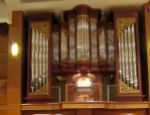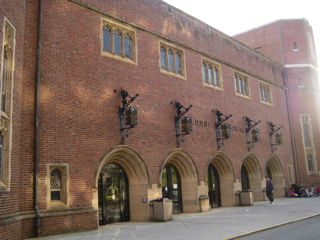By Saturday evening, Friday’s treacherous ice-covered snow had turned to cold rain and messy, deep slush. However, the spectre of soggy shoes and dripping overcoats did not persuade the fans of the University of Tennessee Symphony Orchestra under conductor James Fellenbaum to stay home. Instead, a rather sizable crowd showed up at the James R. Cox Auditorium for an excellent “Vive La France,” a concert of two major works by French composers, plus a brass Fanfare from Paul Dukas’ ballet La Peri conducted by the School’s new Tuba instructor, Kelly Thomas.
On the first half of the evening came Gabriel Fauré’s Requiem in the full orchestra version premiered in 1900, with the UTSO joined by a combined 170+ member chorus consisting of four of the School of Music’s choral organizations: the Chamber Singers, the Concert Choir, and the Men’s and Women’s Chorales.
The seven movements of the Requiem place the “Pie Jesu,” a soprano solo, at the central apex of the construction; the soprano was Caitlin Thomas in a performance graced by a sweet clarity of tone. (The original 1888 “Pie Jesu” was sung by a boy soprano.) The baritone part was split among two soloists, Thaddeus Ennen and Makoto Winkler.
While one might expect such a large combined chorus to betray a lack of crisp responsiveness in this type of Fauré choral writing, this was certainly not the case here; the chorus was amazingly light and agile in all voices, something that felt like essential punctuation against the orchestra. And, youthful choral power really has no equal.
 Maestro Fellenbaum, who has, of late, added one more impressive characteristic to his conducting style by working without a score, was clearly in his element with a big, dynamic work such as that which graced the second half of the evening: the Saint-Saëns “Organ Symphony,” the Symphony No. 3 in C Minor. Fellenbaum’s enthusiasm and passion is highly contagious, the beneficiary being the ensemble, which turned in a very sophisticated performance, aided by Professor John Brock on the Cox Auditorium’s pipe organ. However, as big and dynamic as the work is, it was attention to details of tone and balance that took this performance to a higher level of excitement and attainment. Tight rein was kept on those moments of rhythmic complexity, including the finale’s energetic fugue. And, as expected, the audience was drawn out of their seats by the stupendous organ and orchestra final statement. We would have expected nothing less.
Maestro Fellenbaum, who has, of late, added one more impressive characteristic to his conducting style by working without a score, was clearly in his element with a big, dynamic work such as that which graced the second half of the evening: the Saint-Saëns “Organ Symphony,” the Symphony No. 3 in C Minor. Fellenbaum’s enthusiasm and passion is highly contagious, the beneficiary being the ensemble, which turned in a very sophisticated performance, aided by Professor John Brock on the Cox Auditorium’s pipe organ. However, as big and dynamic as the work is, it was attention to details of tone and balance that took this performance to a higher level of excitement and attainment. Tight rein was kept on those moments of rhythmic complexity, including the finale’s energetic fugue. And, as expected, the audience was drawn out of their seats by the stupendous organ and orchestra final statement. We would have expected nothing less.







